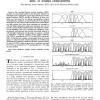Free Online Productivity Tools
i2Speak
i2Symbol
i2OCR
iTex2Img
iWeb2Print
iWeb2Shot
i2Type
iPdf2Split
iPdf2Merge
i2Bopomofo
i2Arabic
i2Style
i2Image
i2PDF
iLatex2Rtf
Sci2ools
112
Voted
TSP
2008
2008
On the Dual-Tree Complex Wavelet Packet and M-Band Transforms
The two-band discrete wavelet transform (DWT) provides an octave-band analysis in the frequency domain, but this might not be "optimal" for a given signal. The discrete wavelet packet transform (DWPT) provides a dictionary of bases over which one can search for an optimal representation (without constraining the analysis to an octave-band one) for the signal at hand. However, it is well known that both the DWT and the DWPT are shift-varying. Also, when these transforms are extended to 2-D and higher dimensions using tensor products, they do not provide a geometrically oriented analysis. The dual-tree complex wavelet transform (DT- WT), introduced by Kingsbury, is approximately shift-invariant and provides directional analysis in 2-D and higher dimensions. In this paper, we propose a method to implement a dual-tree complex wavelet packet transform (DT- WPT), extending the DT- WT as the DWPT extends the DWT. To find the best complex wavelet packet frame for a given signal, we a...
Related Content
| Added | 16 Dec 2010 |
| Updated | 16 Dec 2010 |
| Type | Journal |
| Year | 2008 |
| Where | TSP |
| Authors | I. Bayram, Ivan W. Selesnick |
Comments (0)

